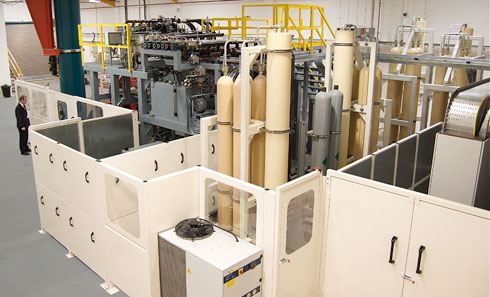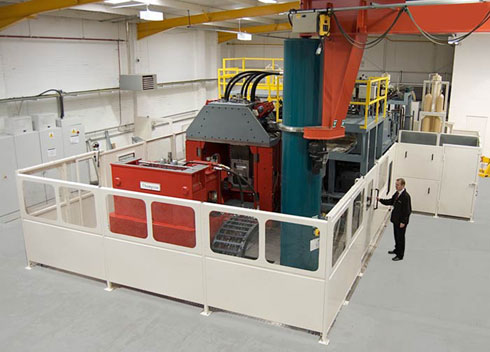Moog, Thompson develop world’s largest linear friction welding machine
Tags: manufacturing
Moog and Thompson Friction Welding have developed the world’s largest linear friction welding machine. It is capable of welding a surface area of 10,000 square millimeters (15 square inches), nearly twice as much as previously achieved, and breaks the record of weld forge load at 100 tonnes.
Designated the E100, this new machine now extends the use of Linear Friction Welding (LFW) in the automotive and aerospace industries to produce components such as vehicle flooring and secure the blades on jet engines.
The E100 machine and control system represent a major industry-breakthrough as friction welding technology had never been used before over such a wide operating envelope. Its automatic handling systems and rapid machine open/close features cut production cycle times when compared with traditional manual operations, while recharging of the accumulators takes only around 30 seconds for the largest and longest welds. The E100 now opens up new possibilities for welded fabrication of parts that previously needed to be machined from solid metal, a process that can result in up to 80 percent material waste. It is set to transform how jet engines are manufactured by cutting production cycle-times and dramatically reducing waste of expensive materials such as titanium.
“Thompson is well known for bringing new and innovative friction welding processes to market, mostly rotary friction welding techniques and machines. Rotary techniques however are not suitable for all components, and we saw the opportunity to develop a machine that would not only bring cost saving benefits to both aircraft and automotive manufacturing through improved welding techniques but also position us as the global market leader in linear friction welding for some time to come,” said Thomson managing director Alan Shilton.
Thompson manufactured the E100 at their facility in the United Kingdom and found the perfect development partner in Moog with the requisite expertise in hydraulics, servo system design, control engineering and manufacturing.
“The challenge presented to us was to develop a hydraulic motion control system to drive a new machine which would break industry convention in terms of size, scale and capacity. This is exactly the kind of challenge we relish at Moog,” said Steve Darnell, regional business manager for North West Europe. “The machine weighs 100 tonnes, is 2.5 meters (100 inches) tall, and has a huge capacity of 100 tonnes in terms of the amount of force that it can apply to a welded joint. This demanded a suitably high performance hydraulic servo system to be designed and built by Moog.”
Moog’s hydraulic servo system and support for the Thompson E100 included:
- A closed-loop control system delivering fast response at high amplitude with advanced digital control techniques delivering precise control over the weld process. Normal servo and proportional valves have a limitation of spool speed and acceleration which prevents the simultaneous delivery of high amplitude and frequency. For the E100, Moog valve spools were made to perform 3 or 4 times faster than normal. Special precautions were necessary to ensure valve integrity over a large number of welds.
- Multiple digitally-controlled Servovalves, which together operate at peak flow rates of up to 4,500 lpm (1,200 gpm) and possess a high frequency range of 75 to 100 Hz for large scale welding. Multiple valves also improve accuracy when the machine is turned down for smaller, lower force welds.
- Hydraulic power plant delivering more than 2 megawatts of instantaneous power needed to drive the system.
- Seven 400-liter (105-gallon) gas volume accumulators each producing massive accumulation to provide the high peak oil flow rate ((4,500 lpm) (1,200 gpm)) required for the weld.
- Manifold and distribution pipe-work installation, a comprehensive sub-system routing oil to multiple active components.
- Experience and expertise in friction welding and project management, design, development, manufacturing, installation and support services.
“It was clear from the start that Moog and Thompson gelled and we had much in common in terms of our expertise in friction welding and hydraulics as well as our commitment to push boundaries of performance to deliver high performance machines. Now here we are, two and a half years later, with this unique machine. Throughout the process, Moog has been very responsive in delivering what we requested of them. We had very specific criteria and requirements for the E100 from the onset, and we had all the tooling and special frequencies of amplitude we wanted the machine to perform at. We depended on Moog to deliver that end result, and they did, demonstrating their expertise in dealing with performance-driven companies." said Alan Shilton.
This is a significant development in light of the unique aspects of Linear Friction Welding (LFW). LFW requires more complex machine architecture and control than rotary techniques, but has the advantage that preformed parts of any shape can be joined. Compared to rotary welding a moving chuck oscillates laterally instead of spinning and the two surfaces are in contact at much higher velocity. This means the two components being welded need to be kept under high pressure at all times.
The benefits of pre-form manufacturing by linear friction welding are numerous. The process, sometimes known as solid-base additive manufacture, allows complex shapes to be manufactured without the wastage of excess material normally associated with machining from solid block, casting or forging, saving both manufacturing time and raw material costs. Manufactured parts are close to the final shape so that very little final machining is required to produce a fully functional component.
Photos


Photo caption
The E100 is a 100-tonne piece of equipment that was manufactured at the Thompson facility in the United Kingdom. To develop the E100, Thompson found the perfect partner in Moog with the requisite expertise in hydraulics, servovalve systems and hydrostatics.